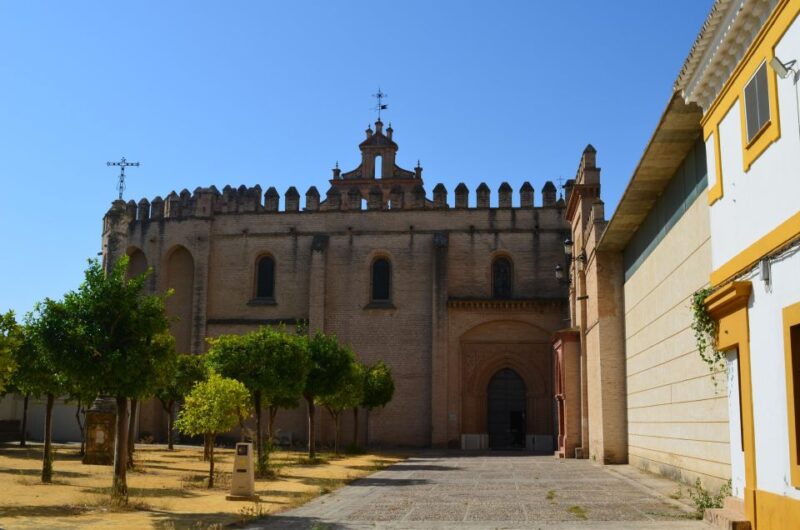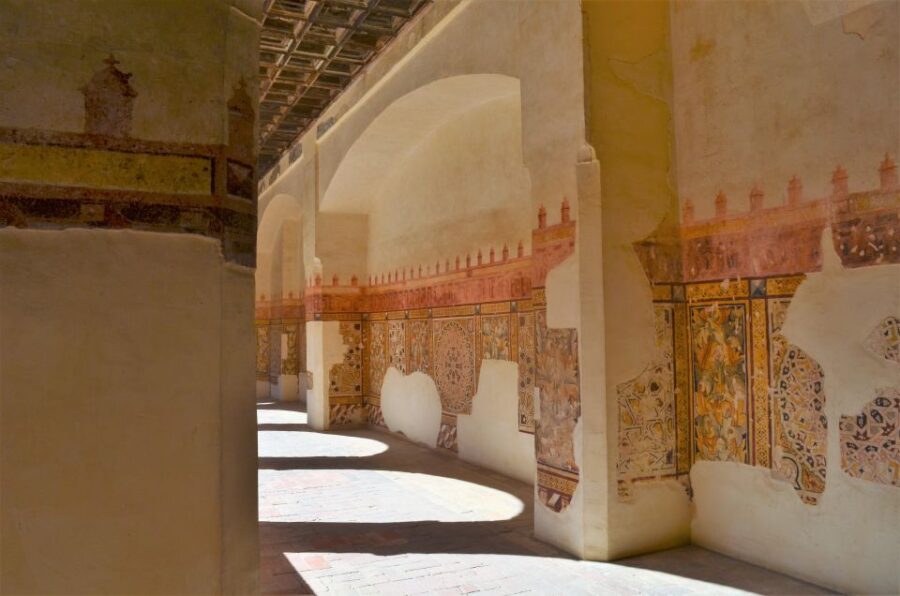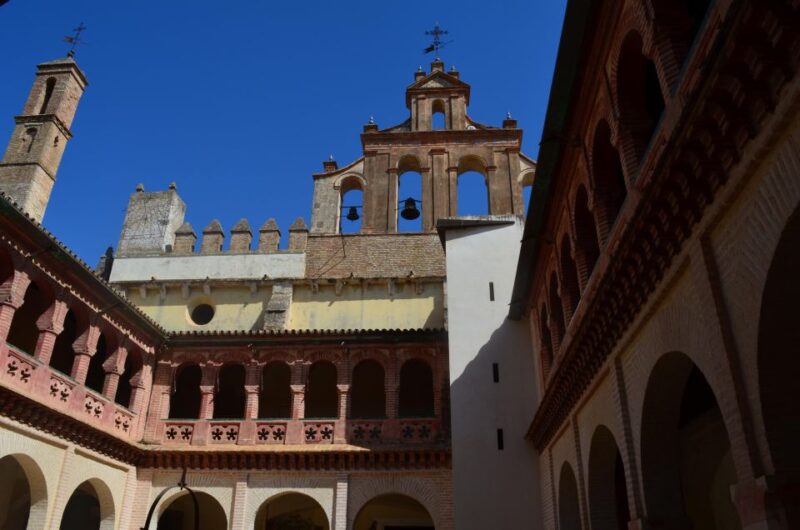The San Isidoro del Campo Monastery stands as a captivating historical landmark in Andalusia, Spain. Established in 1301 by Guzmán El Bueno, this architectural marvel blends Mozarabic and Jerónimos styles, showcasing intricate carvings and frescoes. Beyond its visual splendor, the monastery holds significant cultural importance – it was the first site where the Bible was translated into Spanish, and it later served as a refuge for Protestant thinkers during the Spanish Inquisition. Delving into the monastery’s rich history, one can uncover its dynamic role in shaping the region’s religious and intellectual landscape over the centuries.
Key Points

- The San Isidoro Del Campo Monastery is a cultural landmark with historical significance, including being the site of the first Bible translated into Spanish.
- The monastery features a blend of Mozarabic, Cistercian, and Jerónimos architectural styles, showcasing Andalusia’s diverse monastic legacy.
- Guided tours provide an immersive experience, highlighting the monastery’s notable figures, impressive artwork, and captivating stories.
- The monastery faced religious persecution, with the Cistercians being replaced by the Jerónimos order, reflecting broader religious tensions.
- The monastery also served as a center for Protestantism, with monks translating and distributing forbidden religious texts during a tumultuous era.
Monastery’s Historical Significance
The San Isidoro del Campo Monastery is a medieval jewel that boasts a remarkable history, serving as the site of the first Bible translated into Spanish and the burial place of the renowned Guzmán family.
Founded in 1301 by Guzmán El Bueno as a family pantheon, the monastery’s architectural features reflect its diverse past, transitioning from an initial Mozarabic hermitage to a structure decorated by the Jerónimos after the Cistercians.
This historical significance has made the San Isidoro del Campo Monastery a cultural landmark, with its stories of notable figures and artistic works captivating visitors throughout the ages.
You can also read our reviews of more tours and experiences in Seville.
Architectural Features and Renovations

Architectural magnificence adorns the San Isidoro del Campo Monastery, which started as a Mozarabic hermitage before the Jerónimos order decorated it following the Cistercians’ tenure. The monastery’s rich history is reflected in its evolving architectural styles.
Originally, it followed the simple Mozarabic design, but the later Cistercian and Jerónimos renovations transformed it into a medieval jewel. Ornate carvings, detailed frescoes, and grand cloisters now grace the interior, showcasing the Jerónimos’ artistic flourishes.
Visitors can marvel at the blending of architectural eras, from the Mozarabic foundations to the Jerónimos’ decorative masterpieces. This monastery stands as a testament to Andalusia’s diverse cultural heritage and the enduring legacy of monastic life.
Guided Tour Details

A guided tour of the San Isidoro del Campo Monastery provides visitors with a comprehensive 1.5-hour exploration of this historic site. The tour is conducted in Spanish and is accessible for wheelchair users, with the meeting point located at the Patio de los Naranjos, outside the monastery, marked by a red flag. The highlights of the tour include captivating stories about notable figures and the impressive artistic works within the monastery.
| Tour Details | |
|---|---|
| Duration | 1.5 hours |
| Language | Spanish |
| Accessibility | Wheelchair accessible |
| Meeting Point | Patio de los Naranjos, marked with a red flag |
| Highlights | Guided tour, stories of notable figures, art within the monastery |
Booking and Cancellation Policy
Visitors can reserve their spot on the guided tour of the San Isidoro del Campo Monastery from just €10.12 per person, with no upfront payment required.
They can book their tour now and pay later, and enjoy free cancellation up to 24 hours in advance for a full refund. This flexible booking policy makes it easy for anyone to explore the medieval jewel, which holds the burial site of the Guzmán family and features Mozarabic and Jerónimos architectural influences.
Whether you’re interested in the monastery’s rich history or its impressive art and architecture, the guided tour is an accessible and inclusive way to experience this cultural gem.
More Great Thing To Do NearbyMonastic Orders and Persecution
The San Isidoro del Campo Monastery initially housed Cistercian monks, but they were later replaced by the Jerónimos order due to the persecution of the monks by the Holy Inquisition.
The Cistercians, a strict monastic order, had been overseeing the monastery since its founding in the 14th century. However, the rise of the Spanish Inquisition during the 16th century led to the persecution and suppression of many religious orders, including the Cistercians.
As a result, the Jerónimos, a more lenient monastic order, were brought in to take over the monastery’s operations and ensure its continued existence.
This change in monastic leadership was a significant event in the monastery’s history, reflecting the broader religious and political tensions of the time.
- Alcazar and Cathedral of Seville Tour With Skip the Line Tickets
- Seville Highlights Bike Tour (English)
- White Villages and Ronda Day Tour From Seville
- Sevilla Food Tour: Tapas, Wine, History & Traditions
- Alcazar of Seville Reduced-Group Tour
- Flamenco Show at Tablao El Arenal With Drink and Optional Dinner or Tapas
Cultural Impact and Forbidden Texts
During its remarkable history, the San Isidoro del Campo Monastery played a pivotal role as an important center for Protestantism, where the monks bravely translated forbidden religious texts that challenged the orthodoxy of the time. This courageous act had a profound cultural impact, as the monastery became a haven for those seeking access to alternative theological perspectives.
The monks’ efforts to disseminate these forbidden works were vital in shaping the religious landscape of the era, and their legacy continues to resonate today. Some key ways the monastery influenced the cultural landscape include:
-
Translating and distributing prohibited texts
-
Providing a safe haven for Protestant thinkers
-
Challenging the established religious dogma
-
Fostering intellectual and spiritual exploration
19th Century Usage and Repurposing
After the Jer??nimos order departed, the San Isidoro del Campo Monastery served various purposes throughout the 19th century, including a Malta factory. The once-sacred space was transformed into an industrial facility, where workers produced the renowned Malta beverage. This repurposing of the monastery reflects the changing times and the adaptability of the site to meet the evolving needs of the region.
| Usage | Duration |
|---|---|
| Monastery | 1301 – 19th century |
| Malta Factory | 19th century |
| Other Purposes | 19th century |
The versatility of the San Isidoro del Campo Monastery highlights its enduring significance, as it continued to play a role in the local community, even as its primary function shifted over the centuries.
Visitor Experience and Accessibility
For visitors to the San Isidoro del Campo Monastery, the guided tour offers an immersive experience, exploring the site’s rich history and artistic works. The 100-minute itinerary is recommended for all audiences, with an inclusive and accessible route catering to diverse needs.
The visitor experience includes:
-
A guided tour of the monastery’s interior, led by knowledgeable guides who share stories of notable figures and the site’s artistic treasures.
-
Opportunities to admire the Mozarabic hermitage’s architectural features, as well as the Jerónimos’ decorative work.
-
Wheelchair accessibility, ensuring the tour is inclusive and accessible to all.
-
Striking a balance between historical significance and artistic appreciation, providing a well-rounded understanding of the monastery’s legacy.
Frequently Asked Questions
What Is the Dress Code for Visiting the Monastery?
The dress code for visiting the monastery is generally casual and comfortable. Visitors are advised to avoid revealing or overly informal attire, as the monastery is a sacred religious site. Respectful and modest dress is recommended to fully enjoy the experience.
Are Photography and Filming Allowed Inside the Monastery?
Photography and filming are generally allowed inside the monastery, but visitors should be respectful and avoid disrupting the serene atmosphere. Some areas may have restrictions, so it’s best to check with the staff upon arrival.
Are There Any Gift Shops or Souvenir Stores On-Site?
Yes, there are gift shops and souvenir stores on-site at most monasteries and other historic sites. Visitors can typically find a variety of religious items, books, and locally-made crafts to purchase as souvenirs of their visit.
Are There Any Cafes or Restaurants Within the Monastery Complex?
There are no cafes or restaurants within the monastery complex. However, the nearby town offers a variety of dining options where visitors can enjoy local cuisine and refreshments after their tour.
What Is the Best Time of Day to Visit the Monastery?
The best time to visit a monastery is typically in the morning, when the day is just beginning and the atmosphere is more peaceful. This allows visitors to fully enjoy the tranquil setting.
Recap
The San Isidoro del Campo Monastery is a remarkable testament to Andalusia’s rich history.
Showcasing a harmonious blend of architectural styles, it’s witnessed the region’s religious and political upheavals, serving as a haven and center of cultural influence.
Today, visitors can enjoy its captivating past and admire the monastery’s well-preserved grandeur, making it a must-see destination for those exploring the cultural tapestry of southern Spain.
You can check if your dates are available here:More Tour Reviews in Seville
Not for you? Here's more things to do in Seville we have recnetly reviewed
- 3 Best Canoe And Kayak Experiences In Seville
- 12 Best 2 Day Tours In Seville
- 25 Best Canoe And Kayak Experiences In Seville
- 25 Best Cruises And Boat Tours In Seville
- 13 Best Food Tours In Seville
- 12 Best Full-Day Tours In Seville
- 15 Best Photography Experiences In Seville
- 13 Best Dining Experiences In Seville
- 13 Best Dinner Tours In Seville
- 7 Best Lunch Experiences In Seville
- Horse-Drawn Carriage Private Ride Through Seville
- Caminito Del Rey. 1 Day Excursion.
